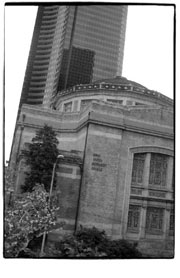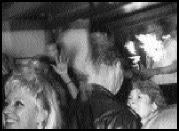PRESERVATIONISTS hate skyscrapers the way anti- capitalists hate the Gap. So it shouldn’t come as any surprise that Seattle’s historic preservation community, led by Seattle City Council President Peter Steinbrueck and Historic Seattle, has rallied round the old First United Methodist building at Fifth and Marion. The groups hope to save the 94-year-old sanctuary, which is slated to be torn down and turned into a 32-story, 590,000-square-foot office tower sometime in the next few years.
The historic church will only survive if preservation advocates can figure out a way to compensate the congregation (the site was most recently appraised at $9.2 million), salvage the earthquake-damaged building, and find an economically viable use for the structure.
The downtown sanctuary is the third for the church, which started in a log cabin in 1853; 30 people—the entire white population of Seattle—attended the first evening service. The church outgrew two subsequent buildings by 1908, when it moved into the current Beaux Arts-style sanctuary. At the time, it had a thriving membership of around 1,800 souls. But the building, with its seating capacity of about 1,200, now dwarfs the current Sunday attendance of about 300. Massive damage from the Nisqually earthquake— repairs cost the church around $350,000, but major structural damage remains—have added to the church’s financial burden.
Given those economic pressures, says Steinbrueck, “It is very, very difficult for [such] churches to resist temptation” to cash in on their investments.
Church spokesperson Steve Poole says the congregation was faced with a lose-lose situation: “Do we need to focus our energy on maintaining the building, or do we need to focus on maintaining the ministry and outreach that we’re doing? We’ve decided we need to maintain the ministry.”
But how to do that without destroying a gem of historic architecture amid the steel-and-glass boxes that frame downtown Seattle has proved a far more challenging question. Even preservationists, who lost their 10- year court battle against the congregation to obtain protective landmark status for the building, admit their options are limited. “Restoring a church tends to be more difficult than restoring a garden-variety building,” because funds for church restoration, both governmental and private, are extremely hard to come by, says Heather MacIntosh of Historic Seattle, an arm of city government that works to preserve historic buildings. And converting the church to a nonreligious use, an option that would open it to another restoration battle, may create difficulties of its own.
Steinbrueck, an architect, has been discussing some of the possibilities for “adaptive reuse” of the sanctuary with Historic Seattle, the local chapter of the American Institute of Architects, and church leadership. The most obvious alternative, turning the space over as a public meeting and concert facility along the lines of Town Hall—a former Christian Science sanctuary—probably isn’t viable, Steinbrueck says. “We recognize that economic viability is essential,” Steinbrueck says. “I don’t think we can do another Town Hall; we’ve already got enough of those.”
Other possibilities, such as turning the building into a museum, converting it into an atrium for a future office tower, or using it as a health club for the nearby Rainier Club, present their own financial and architectural challenges. Adding to that is what Town Hall founder David Brewster calls the “awkward timing” of the church’s application for demolition. “It comes at the end of a building spree, when a lot of natural organizations [that could fill the space] have taken care of their building problems.” But smaller museums, like the Wing Luke Asian Museum, might find the building a suitable fit, Brewster says.
Any decision on the future of the church site is still, at a minimum, two years out, which gives preservationists and the Methodists plenty of time to come up with a solution that saves the church without destroying the congregation.







